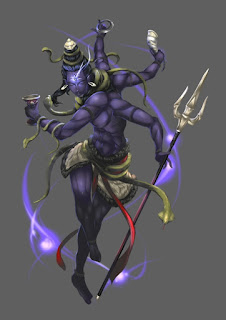Dear all, let me now outline about a sadhana which has nothing to do with aghora per say, but aghoris practice it just for understanding of the mantra devatha. This is a sadhana in which the deity is Rudra in the ferocious form. Rudra here is shiva and the vedic god Rudra himself. Astra: sleem pashu hum phal. Purpose: The mantra of Srī Aghora pratyaṅgira mantra is considered ultra-powerful in destroying all types of enemies, internal and external, competitors and any other types of adversaries or adverse situations one may find themselves in. It acts as a weapon in clearing our karmas and purifying us within and removing all ills impacting us.
Dear all, let me now outline about a sadhana which has nothing to do with aghora per say, but aghoris practice it just for understanding of the mantra devatha.
This is a sadhana in which the deity is Rudra in the ferocious form. Rudra here is shiva and the vedic god Rudra himself.
Astra : sleem pashu hum phal
Moola : Om hreem sfpura sfpura prasfpura prasfpura ghoraghorathara thanuroopa chada chada prachada prachada kaha kaha vama vama bandha bandha khataya khataya hum phal
Anga :
1) Om hreem sfpura sfpura hrudayaya nama:
2) prasfpura prasfpura sirasae swaha
3) ghora ghoratanuroopa shikhayae vashal
4)chada chada prachada prachada kavachaaya hum
5) kaha kaha vama vama nethrathryaaya vaushal
6) bandha bandha khataya khataya hum phal astraaya phal
Chanda : aghora rishi , anushtup chanda , aghorarudrau devatha
Dhyana : omitted on purpose
peeta pooja , peeta samasti , peeta pooja as per shiv panchakshari sadhana
Moorti kalpana, peeta shakthi ,moola and aghorarudramoorthayae nama:
Upachara and avahana as per shiv panchakshari sadhana except the ayudha nyasas which is mentioned below
Ayudha :
1) parashavae nama:
2) damaravae nama:
3) khadgaaya nama:
4) khetaaya nama:
Bhushana and upahara as per shiv panchakshari sadhana
Moorthi pooja - pranava thraya, upachara, moola thraya, moolakshara, anga, ayudha, bhushana, angaavarana culminated with parashavae nama: starting now with parashwathi (8), indradi (10), vajradi (10), chandeshwaraya nama: nirmalyadhari mantra, do pooja with water from beginning to end .
Dwadastas to naivedya and remaining as per shiv panchakshari sadhana .
iti aghorarudra sadhana samaptam |
Introduction
- In Hinduism
- Languages

Introduction:
Aghora means something in Hinduism, Sanskrit, Marathi. If you want to know the exact meaning, history, etymology or English translation of this term then check out the descriptions on this page. Add your comment or reference to a book if you want to contribute to this summary article.
Aghor Rudra Mantra
Images (photo gallery)

In Hinduism


Shilpashastra (iconography)
Aghora Rudra Mantra Youtube
 Source: Wisdom Library: Elements of Hindu Iconograpy
Source: Wisdom Library: Elements of Hindu Iconograpy1) Aghora (अघोर):—One of the five aspects of Śiva, known collectively as the Pañchabrahmās. They are emanations from the niṣkala-Śiva. According to the Rūpamaṇḍana, the face of Aghora should be of terrific look, set with three yellow coloured eyes and the mouth having side tusks; on the head there should be a garland of human skulls and a snak, and snake ornaments everywhere; two snakes serving as the ear-rings, two others as keyūras, one as hāra, one as yajñopavīta, one as kaṭisūtra (the waist-zone), the snakes Takṣa and Puṣṭika as anklets, and so on; there should also be a garland composed of scorpions (vṛśchika). The colour of the body of Aghora should be blue like the nīlotpala, and that of the jaṭās, yellow, and these should be adorned with the crescent moon.
The general look of this aspect of Śiva should resemble that of Kāla (the god of death) and appear as though terrifying a host of enemies. The left hands should bear in them the khaṭvāṅga, the kapāla, the kheṭaka and the pāśa while the right ones, the triśūla, the paraśu, the khaḍga and the daṇḍa.
The Śrītatvanidhi gives somewhat different description. For Aghora should have, according to this work, four; each of these faces should have three eyes; the colour of Aghora should be blue. This face ought to point to the southern direction. There should be the paraśu, veda (a book?), aṅkuśa, pāśa, śūla, kapāla, ḍhakka and akṣamālā in the hands of Aghora.
2) Aghora (अघोर):—Second of the twelve emanations of Rudra, according to the Rūpamaṇḍana.
Shilpashastra (शिल्पशास्त्र, śilpaśāstra) represents the ancient Indian science (shastra) of creative arts (shilpa) such as sculpture, iconography and painting. Closely related to Vastushastra (architecture), they often share the same literature.